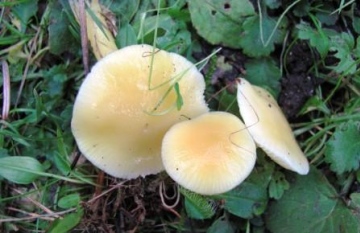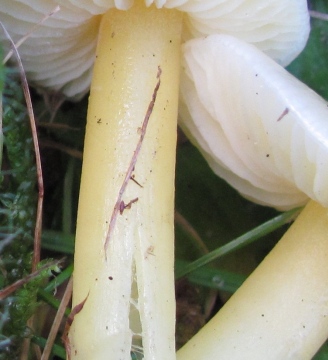Sunday November 14th : In contrast with many other groups of fungi it has been a relatively poor year for waxcaps in Essex. The Club foray on November 6th (which unfortunately I was unable to attend) recorded only four species from Fryerning and the best I have managed there on my weekly visits has been five, namely, Hygrocybe virginea, pratensis, ceracea, chlorophana and coccinea. My visit today established that the season was drawing to a close for most fungi species but among the few waxcaps found was a group of seven pale yellow specimens growing close to the church. At first I took them to be H.ceracea, which is common at the churchyard, but picking one proved to be nigh on impossible without a knife to dig them out as both the cap and stem were glutinous; indeed when holding the latter against the light globules of slime could be seen adhering to the surface. Although ceracea can occasionally have a viscid cap the stem is usually dry. I then realised they were probably H.glutinipes, as although I had not recorded this species at the churchyard for five years these were growing in almost exactly the same spot I had found it previously. Examination at home confirmed this. Macro features include the glutinous cap and stem as already mentioned. Also, the adnate rather than decurrent gills help distinguish it from two similar species, H. vitellina and H. laeta (although this feature can vary), but those species have a viscid edge to the gills whereas on glutinipes it is dry. Also, both those species have a largely northern distribution in Britain. H.insipida, which is of regular occurence in the churchyard,also has a viscid stipe when fresh but this soon wears off on handling; also the fruit body is often tinged with red, the cap lacks a translucent, whitish margin and the gills are usually decurrent rather than adnate. The spores of glutinipes are also slightly larger, the ten measured today varying between 7 and 10 um.
Most of these features should be discernible on the photographs, although the pale yellow coloration has begun to fade to pale orange (another colour variation) between collecting and photographing and even with the most careful handling the slime has a habit of transfering from the observed to the observer! In his article on the Waxcaps of Essex (EN Vol.21 ps 131-141) lists two sites for this species in Essex, namely, my own record here at Fryerning and also an EWT record from Copperas Wood, Wrabness. There are currently no records on the BMS online database.




















